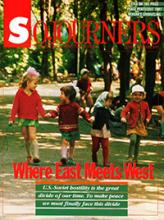In the last 10 years, a truly remarkable thing has happened in our country and in most of the world. The widespread alarm of ordinary citizens at the prospect of nuclear war has become a major factor in domestic politics and international diplomacy. Humanity's silence in the face of a precarious balance of terror has been decisively broken. From town councils and church committees to houses of parliament and super-power summits, the question of nuclear war is finally at, or near the top of, the public agenda.
That great awakening didn't just happen. It was in large part the result of hard work and difficult struggle on the part of thousands of dedicated activists. And churches and Christian communities, in fact many of the readers of this magazine, played a key role in that process. Because of those efforts, combined with the tides of history and providence, we now live in a world where masses of people in almost every nation are awakened and mobilized against the nuclear threat.
We called for a freeze on the production, testing, and deployment of new nuclear systems. And that call was ratified by an overwhelming majority of the American people. We called for one of the superpowers to break the deadly cycle with a bold, unilateral initiative for peace. And with the Soviet testing moratorium, that has come to pass. Even our fondest and often unspoken dream--the complete elimination of nuclear weapons as instruments of national security--is now discussed with apparent seriousness by world leaders. We can look back over the last decade and, paraphrasing the hack politician's dying words in The Last Hurrah, say to ourselves, "We've done great things--among others."
Read the Full Article

